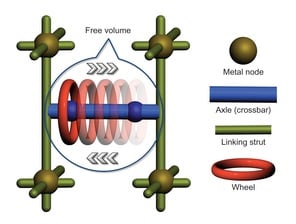
Since advanced nanotechnology will be primarily about complex systems of artificial molecular machines, it is very nice to see the journal Nature begin the month with a very useful overview of molecular machines, presented as a News Feature written by Mark Peplow “The tiniest Lego: a tale of nanoscale motors, rotors, switches and pumps“:
The robot moves slowly along its track, pausing regularly to reach out an arm that carefully scoops up a component. The arm connects the component to an elaborate construction on the robot’s back. Then the robot moves forward and repeats the process — systematically stringing the parts together according to a precise design.
It might be a scene from a high-tech factory — except that this assembly line is just a few nanometres long. The components are amino acids, the product is a small peptide and the robot, created by chemist David Leigh at the University of Manchester, UK, is one of the most complex molecular-scale machines ever devised.
We commented on this advance in January 2013. Returning to the Nature review:
It is not alone. Leigh is part of a growing band of molecular architects who have been inspired to emulate the machine-like biological molecules found in living cells — kinesin proteins that stride along the cell’s microscopic scaffolding, or the ribosome that constructs proteins by reading genetic code. Over the past 25 years, these researchers have devised an impressive array of switches, ratchets, motors, rods, rings, propellers and more — molecular mechanisms that can be plugged together as if they were nanoscale Lego pieces. And progress is accelerating, thanks to improved analytical-chemistry tools and reactions that make it easier to build big organic molecules.…
Prof. Leigh was winner of the 2007 Foresight Feynman Prize for Theoretical work. Other Feynman Prize winners whose work is mentioned in the review were Fraser Stoddart (2007, Experimental work), James Heath (cowinner 2000, Experimental work), Nadrian Seeman (1995), and R. D. Astumian (2011, Theoretical work).
One of the earliest reviews of artificial molecular machines, and arguably the most comprehensive, titled “Synthetic Molecular Motors and Mechanical Machines” [abstract] was published in December 2006, written by Prof. Leigh in collaboration with Euan R. Kay and Francesco Zerbetto, and was recommended here by Christine Peterson. One of the clearest signs of accelerating progress since then that Peplow presents is the debut of a new Gordon Research conference a few months ago “Artificial Molecular Switches & Motors“.
After tracing the field to the rotaxane molecules pioneered by Fraser Stoddart to build the first molecular shuttle, Peplow follows it to the present. One recent advance he cites is the use of metal-organic-frameworks to organize arrays of molecular shuttles inside porous crystals—an advance we also pointed to. Also acknowledged are DNA walkers and similar DNA nanostructures, and the discovery of common operating principles between artificial molecular machines and biological machines made from protein and RNA.
This review presents a clear picture of a field that has gathered a lot of momentum over the past couple decades and is ready for both practical applications of simple switches and simple molecular machines, and integrating molecular machines and frameworks toward more complex functions and applications. Biology suggests that such integration could lead to interesting structures and functions.
—James Lewis, PhD